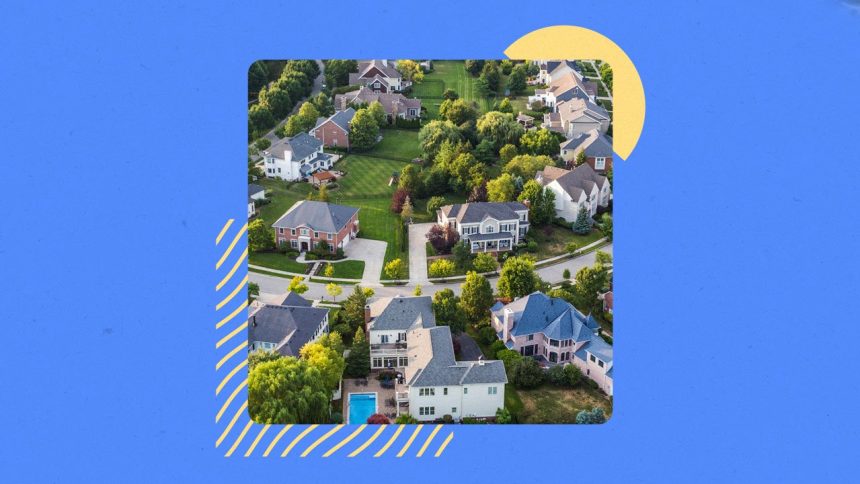Key takeaways
- Looking at the past four decades, the average rate on a 30-year fixed mortgage peaked in 1981, rising to roughly 16 percent.
- The average 30-year fixed rate bottomed in 2021 at just under 3 percent.
- For much of 2024, the cost of a typical 30-year fixed mortgage had been in the high-6 and 7 percent range. In August, 30-year rates plummeted to 6.5 percent.
The residential mortgage as we know it today is less than a century old. In fact, until the Federal Housing Administration (FHA) was established in 1934, only one in 10 Americans even owned a home. That all changed with the introduction of the 30-year fixed-rate mortgage during the Great Depression, which made homeownership possible for millions.
Mortgage rates over time
-
Below is a summary of the average 30-year fixed mortgage rate by year. From the mid-1980s on, the rates reflect Bankrate’s calculation of the effective mortgage rate, which takes into account the average number of points borrowers pay. The data from the 1970s to the early 1980s is based on Freddie Mac’s reporting.
Year 30-year fixed-rate average Sources: Bankrate, Freddie Mac 2023 7.00% 2022 5.53% 2021 3.15% 2020 3.38% 2019 4.13% 2018 4.70% 2017 4.14% 2016 3.79% 2015 3.99% 2014 4.31% 2013 4.16% 2012 3.88% 2011 4.65% 2010 4.86% 2009 5.38% 2008 6.23% 2007 6.40% 2006 6.47% 2005 5.93% 2004 5.88% 2003 5.89% 2002 6.57% 2001 7.01% 2000 8.08% 1999 7.46% 1998 6.91% 1997 7.57% 1996 7.76% 1995 7.86% 1994 8.28% 1993 7.17% 1992 8.27% 1991 9.09% 1990 9.97% 1989 10.25% 1988 10.38% 1987 10.40% 1986 10.39% 1985 12.43% 1984 13.88% 1983 13.24% 1982 16.04% 1981 16.64% 1980 13.74% 1979 11.20% 1978 9.64% 1977 8.85% 1976 8.87% 1975 9.05% 1974 9.19% 1973 8.04% 1972 7.38%
1970s mortgage rate trends
The 30-year fixed-rate mortgage — now the most popular type of home loan — started the decade at about 7.3 percent in 1971, according to Freddie Mac. By the end of 1979, the 30-year rate was at 12.9 percent. During this decade, the Federal Reserve’s expansionary policy and other factors helped drive inflation and borrowing costs way up.
1980s mortgage rate trends
At the beginning of 1980, homes in the U.S. cost a median of $63,700, according to the Department of Housing and Urban Development (HUD). By 1990, that median had risen to $123,900. Spurred by the Great Inflation, the 30-year fixed mortgage rate reached a pinnacle of 18.4 percent in October 1981, according to Freddie Mac. Once the Fed reined in inflation, the 30-year rate seesawed down to the 9 percent range, closing the decade at 9.78 percent.
1990s mortgage rate trends
The 1990s saw a dramatic shift in the 30-year rate, which plunged to an average of 6.91 percent in 1998, according to Bankrate data. This drop was brought on by the dot-com bubble, an era when investors rushed to buy stocks from technology companies that were overvalued. When these stocks plummeted, investors turned their focus to fixed-income investments, such as bonds. As bond prices rose and yields fell, mortgage rates, which follow the 10-year Treasury yield, also declined.
2000s mortgage rate trends
The 30-year rate took another tumble in the latter half of the 2000s when the housing market crashed in the subprime mortgage crisis. The average 30-year fixed mortgage rate dropped from about 8 percent at the start of the decade down to 5.4 percent by 2009, according to Bankrate data. At this time, the Federal Reserve implemented quantitative easing measures, buying mortgage bonds in bulk to drive down interest rates and usher in an economic recovery.
2010s mortgage rate trends
In the 2010s, the 30-year mortgage rate continued to trend downward, beginning in the 4 percent range, dipping under the 4 percent mark and then ending the decade back in that range, according to Bankrate data. These low rates were brought on in part by the Federal Reserve’s pull-back on bond-buying.
2020s mortgage rate trends
2020 saw new lows for mortgage rates, with the 30-year fixed rate diving to just under 3 percent, according to Bankrate data, and averaging 3.38 percent for the year. Amid the pandemic, fearful investors were attracted to safer products such as Treasury and mortgage bonds, pushing yields — and rates — lower.
2020 brought new lows for mortgage rates, with the 30-year fixed rate diving to just under 3 percent, according to Bankrate data, and averaging 3.38 percent for the year. Amid the pandemic, fearful investors were attracted to safer products such as Treasury and mortgage bonds, pushing yields — and rates — lower. Rates began to creep back up in 2021, but the ongoing pandemic ultimately tempered their rise.
Then came 2022 and 2023. Determined to curb rampant inflation, the Federal Reserve began raising its benchmark interest rate, and mortgage rates followed suit. In October 2022, the 30-year rate breached 7 percent but settled back into the 6 percent range for the first half of 2023. By July 2023, rates had reversed course, and by October, the 30-year broke through 8 percent.
For much of 2024, 30-year rates have been in the low 7s, hitting a high of 7.39 percent in May.
More recently, rates have tumbled to the 6.5 percent range, thanks in part to a July jobs report that stoked fear in the markets, plus calls for multiple Fed rate cuts before the end of the year.
Mortgage rate predictions
While we can try to guess based on historical data, no one knows for certain what will happen to future mortgage rates over time — whether they’ll change at all, or when. The economy and housing market are cyclical, experiencing ups and downs, at times unpredictably.
Still, we regularly ask economists and other experts to weigh in. For week-to-week predictions, check out our mortgage rate poll. For a monthly look-ahead, read our latest mortgage rate forecast.
How historical mortgage rates affect buying a home
Broadly speaking, lower mortgage rates fuel demand among homebuyers and can increase an individual’s buying power. A higher rate, on the other hand, means higher monthly mortgage payments, which can be a barrier for a buyer if the cost becomes unaffordable. In general, a borrower with a higher credit score, stable income and a sizable down payment qualifies for the lowest rates.
While you should keep an eye on mortgage rates, don’t try to time the market or predict what’ll happen. While a home is an investment, it’s also where you live. In general, it’s best to get a mortgage only if you can afford it and when the time is right for you.
How historical mortgage rates affect refinancing
When mortgage rates are on the upswing, it might make less financial sense to try to refinance. Generally, it’s best to refinance if you can shave off one-half to three-quarters of a percentage point from your current interest rate, and if you plan to stay in your home for a longer period. If you plan to sell your home soon, the cost to refinance might not be worth it.
Read the full article here














